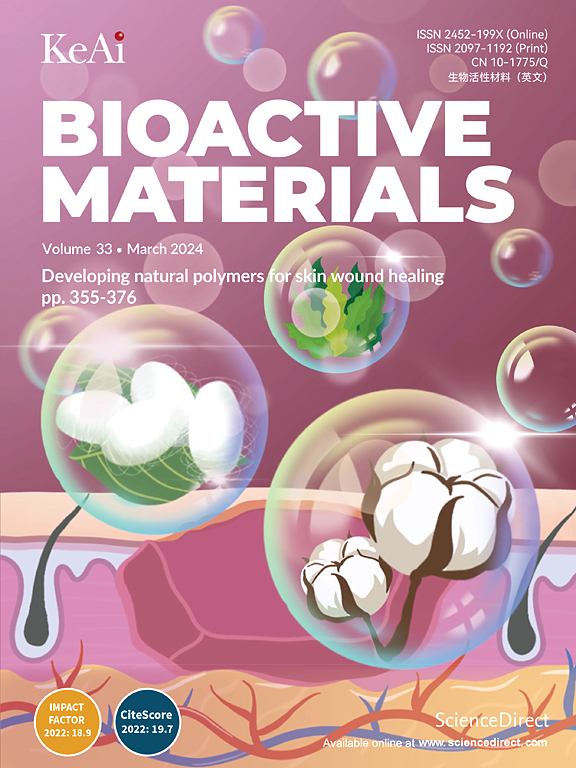Tailoring hyaluronic acid hydrogels: Impact of cross-linker length and density on skin rejuvenation as injectable dermal fillers and their potential effects on the MAPK signaling pathway suppression
IF 18
1区 医学
Q1 ENGINEERING, BIOMEDICAL
引用次数: 0
Abstract
Hyaluronic acid (HA) hydrogels, obtained through cross-linking, provide a stable 3D environment that is important for controlled delivery and tissue engineering applications. Cross-linking density has a significant impact on the physicochemical properties of hydrogels, including their shape stability, mechanical stiffness and macromolecular diffusivity. However, often cross-linking chemistries require photoinitiator and catalyst that may be toxic and cause unwanted tissue response. Here, we prepared a series of HA hydrogel with varying cross-linker length and cross-linking density, which can be obtained by altering the feed ratio of three different cross-linkers from small molecules to macromolecules (e.g., 1,4-butanediol diglycidyl ether (BDDE), ferulic acid (FA), pluronic (PLU)), to ameliorate skin wrinkles in mice models. HA cross-linked with FA and PLU exhibited enzyme and temperature-dependent sol-to-gel phase transition, respectively, and the gels possess good injectability. In vitro test confirmed that HA hydrogels co-cultured with RAW 264.7 and HDF cells showed good biocompatibility. In particular, HA cross-linked with PLU stimulated the growth of HDF cells and HaCaT cells. HA cross-linked with PLU suppressed the expression levels of proteins involved in collagen degradation including mitogen-activated protein kinases (ERK, JNK, p38) and matrix metalloproteases (MMP-1, MMP-3, and MMP-9) resulting in increased deposition of Collagen I. The free-flowing sols of HA hydrogel precursors are subcutaneously injected into the back of BALB/c mice and form stable gels at the dermis layer and found to be non-toxic. More importantly, HA hydrogel cross-linked with PLU showed an enhanced anti-wrinkling effect in the wrinkled mice model. Thus, properties of HA hydrogels such as injectability, biocompatibility, and good anti-wrinkling effect altered through varying cross-linking density must be considered in the context of soft tissue engineering applications.

定制透明质酸水凝胶:交联剂长度和密度对皮肤再生的影响,可注射真皮填充剂及其对MAPK信号通路抑制的潜在影响
通过交联获得的透明质酸(HA)水凝胶提供了稳定的3D环境,这对于控制输送和组织工程应用非常重要。交联密度对水凝胶的物理化学性质有重要影响,包括形状稳定性、机械刚度和大分子扩散率。然而,通常交联化学反应需要光引发剂和催化剂,这可能是有毒的,并引起不必要的组织反应。本研究通过改变三种不同交联剂(如1,4-丁二醇二甘油酯醚(BDDE)、阿威酸(FA)、pluronic (PLU))从小分子到大分子的投喂比,制备了一系列不同交联剂长度和交联密度的透明质酸水凝胶,改善小鼠模型皮肤皱纹。HA交联FA和PLU分别表现出酶依赖性和温度依赖性的溶胶-凝胶相变,凝胶具有良好的注射性。体外实验证实HA水凝胶与RAW 264.7和HDF细胞共培养具有良好的生物相容性。特别是,与PLU交联的HA刺激了HDF细胞和HaCaT细胞的生长。与PLU交联的HA抑制了参与胶原降解的蛋白质的表达水平,包括丝裂原活化蛋白激酶(ERK、JNK、p38)和基质金属蛋白酶(MMP-1、MMP-3和MMP-9),导致胶原i的沉积增加。将自由流动的HA水凝胶前体溶胶皮下注射到BALB/c小鼠的背部,在真皮层形成稳定的凝胶,发现无毒。更重要的是,与PLU交联的HA水凝胶在皱纹小鼠模型中显示出增强的抗皱作用。因此,在软组织工程应用的背景下,必须考虑透明质酸水凝胶的可注射性、生物相容性和良好的抗皱效果等性能,这些性能会随着交联密度的变化而改变。
本文章由计算机程序翻译,如有差异,请以英文原文为准。
求助全文
约1分钟内获得全文
求助全文
来源期刊

Bioactive Materials
Biochemistry, Genetics and Molecular Biology-Biotechnology
CiteScore
28.00
自引率
6.30%
发文量
436
审稿时长
20 days
期刊介绍:
Bioactive Materials is a peer-reviewed research publication that focuses on advancements in bioactive materials. The journal accepts research papers, reviews, and rapid communications in the field of next-generation biomaterials that interact with cells, tissues, and organs in various living organisms.
The primary goal of Bioactive Materials is to promote the science and engineering of biomaterials that exhibit adaptiveness to the biological environment. These materials are specifically designed to stimulate or direct appropriate cell and tissue responses or regulate interactions with microorganisms.
The journal covers a wide range of bioactive materials, including those that are engineered or designed in terms of their physical form (e.g. particulate, fiber), topology (e.g. porosity, surface roughness), or dimensions (ranging from macro to nano-scales). Contributions are sought from the following categories of bioactive materials:
Bioactive metals and alloys
Bioactive inorganics: ceramics, glasses, and carbon-based materials
Bioactive polymers and gels
Bioactive materials derived from natural sources
Bioactive composites
These materials find applications in human and veterinary medicine, such as implants, tissue engineering scaffolds, cell/drug/gene carriers, as well as imaging and sensing devices.
 求助内容:
求助内容: 应助结果提醒方式:
应助结果提醒方式:


